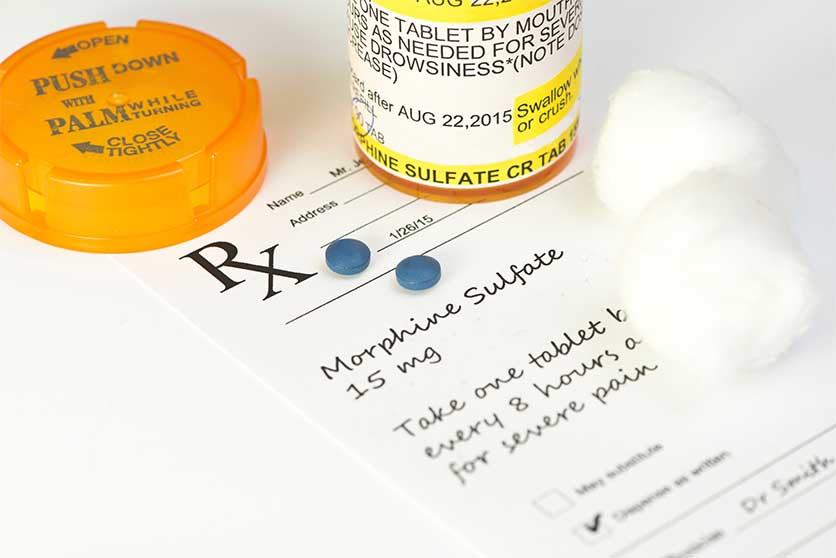Morphine Dosage Guide | 10mg – 200mg
Morphine is an effective opiate/opioid pain relief medication administered through injection, oral solutions, and oral tablets or capsules. Starting doses vary but are generally between 10 and 30 mg for adults. Taking more morphine than prescribed is a likely sign of drug abuse.

The classical opiate drug morphine sulfate acts as a strong opioid receptor agonist and painkiller.
Although a large number of opioid analgesics have been approved in many different formulations, morphine remains a widely used and crucial tool for the treatment of severe pain and chronic pain.
Typical Morphine Doses
Morphine dosage varies from patient to patient depending on age, size, weight, tolerance, method of administration, and the medical condition being addressed.
FDA-recommended starting morphine doses include:
- for direct intravenous injection, treatment is initiated with a single dose of .01 mg to .02 mg per kg of body weight every four hours
- for intramuscular or subcutaneous injection, treatment is initiated with around 10 mg or every four hours
- for oral morphine tablets, the recommended starting dose is 15 to 30 mg taken every four hours as needed
- extended-release oral morphine tablets or capsules should be taken less often, as indicated on your prescription, usually every 8, 12, or 24 hours with or without food
- for morphine oral solution, the recommended starting dose is 10 to 20 mg taken every four hours as needed
Starting dosage for pediatric patients must be established situationally by a healthcare provider.
In general, prescribing healthcare providers will attempt to use the lowest effective opioid dose for the shortest duration required to treat your pain. This means your daily dose may need to be increased or decreased through a process known as titration before the correct concentration of the medication is achieved.
Proper Use Of Morphine
Always consult the information provided with your prescription before beginning treatment.
Morphine is a very strong, potentially dangerous, and potentially habit-forming pain management medication. It should only ever be taken as prescribed by a licensed healthcare provider.
Morphine should be kept with its container closed in a secure room-temperature location outside of the reach of children or other individuals to whom it has not been prescribed. Any unused morphine should be returned to drug take-back locations as soon as possible or flushed down the toilet.
Side Effects Of Morphine Use
The most common side effects of morphine use are:
- drowsiness
- dizziness, lightheadedness, or fainting
- stomach pain and cramps
- constipation
- dry mouth
- headache
- nervousness
- mood changes
- small pupils
- difficulty or pain while urinating
Other unusual adverse effects, including allergic reactions, are possible. Contact your healthcare provider immediately if you have any concerns.
Risks Of Morphine Use
Morphine is prescribed when a healthcare provider believes that the analgesia it provides outweighs the potential risks of its use.
These potential risks include:
- adverse effects, which should be reported to your doctor as soon as possible
- interactions with other drugs/supplements including certain antidepressants
- risks related to fertility, pregnancy, and breastfeeding
- low blood pressure leading to dizziness, unsteadiness, fainting, and/or falling down when a person moves from sitting or lying down to a standing position
- sedation and impairment that can make it dangerous to operate a motor vehicle or machinery
- severe constipation and paralytic ileus, a serious condition in which digested food stops moving through the intestines
- development of physical dependence, leading to withdrawal symptoms that emerge after discontinuation
Morphine Alternatives
While morphine is a proven option for pain control in a variety of situations, there are other modern options that can be administered if needed. These include:
- oxycodone
- hydrocodone
- hydromorphone
- fentanyl
- codeine
- meperidine
- oxymorphone
- tramadol
- non-opioid analgesics like acetaminophen, ibuprofen and aspirin
These pain relief drugs come in a wide variety of forms including tablets, capsules, injections, transdermal patches, oral transmucosal lozenges (lollipops), and more.
Morphine Abuse
Morphine abuse occurs if you:
- increase your dosage
- take morphine more often than prescribed
- tamper with your medication to increase its effects
- take morphine with other drugs or alcohol
Abusing morphine is likely to increase the effects of sedation and impairment, and can lead to severe or even life-threatening adverse events.
Morphine Overdose
Use of overly high doses of morphine can lead to serious or life-threatening overdose effects including respiratory depression (impaired breathing).
Morphine toxicity is most likely to occur when morphine or another opioid drug is:
- used by someone who has not developed opioid tolerance or who has lost their tolerance
- someone who is combining morphine with other CNS depressants (alcohol, benzodiazepines, other opioids, muscle relaxers, etc.)
- someone taking high doses of morphine recreationally
A morphine overdose can be treated using the opioid antidote drug naloxone (Narcan).
Treatment For Morphine Abuse
Morphine abuse can occur for a wide variety of reasons, but generally leads to physical dependence and drug addiction.
Fortunately, proven treatment options for opioid addiction are available, including:
- medical detoxification to help manage morphine withdrawal syndrome
- inpatient/residential care
- medication-assisted treatment using methadone, buprenorphine, and naltrexone
- dual diagnosis care for co-occurring mental health disorders
- aftercare support
To learn how we treat morphine addiction on an inpatient basis, please contact Ohio Recovery Center today.
- Food And Drug Administration (FDA) — Morphine Sulfate injection label https://www.accessdata.fda.gov/drugsatfda_docs/label/2016/204223s006lbl.pdf
- Food And Drug Administration (FDA) — Morphine Sulfate solution label https://www.accessdata.fda.gov/drugsatfda_docs/label/2012/022195s006lbl.pdf
- Food And Drug Administration (FDA) — Morphine Sulfate tablets label https://www.accessdata.fda.gov/drugsatfda_docs/label/2012/022207s004lbl.pdf

